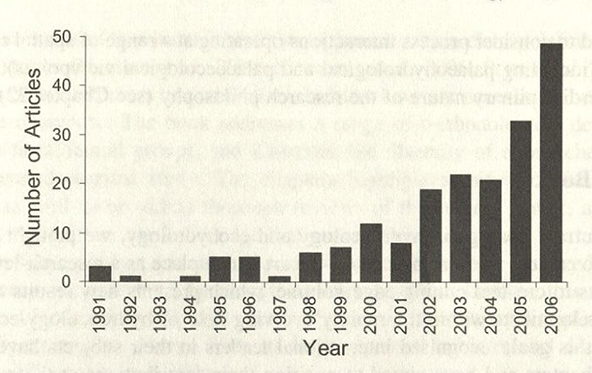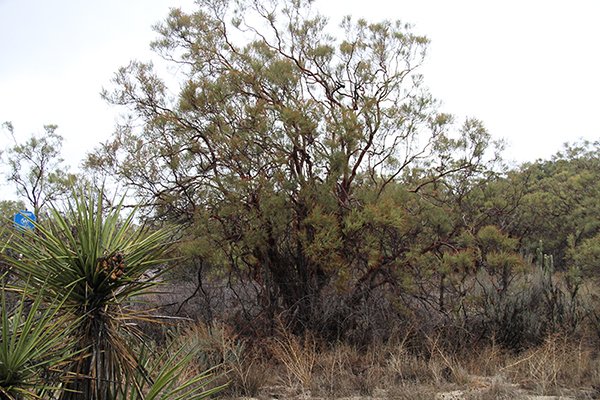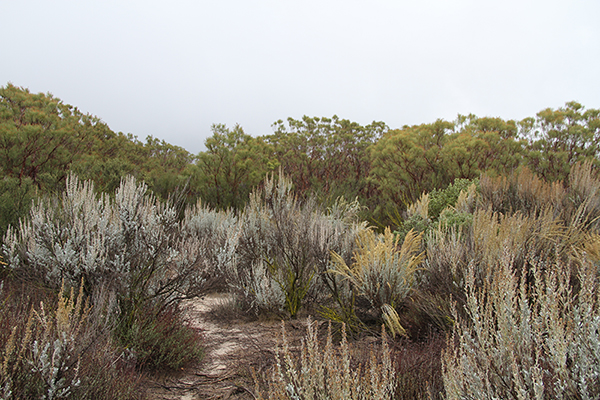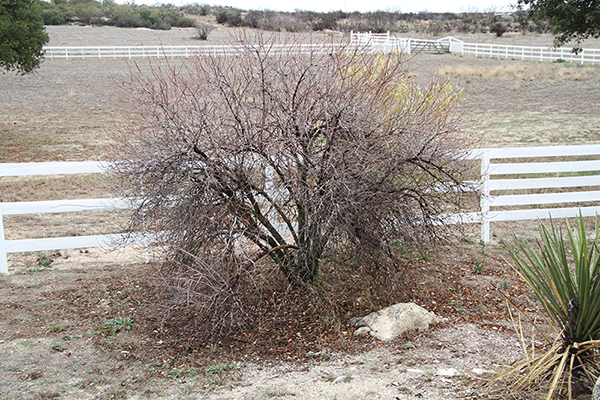CIV E 633 - Environmental Hydrology Fall 2013 Project
Progress in Ecohydrology after Meinzer
ROSA AGUILAR
December 11, 2013
1. INTRODUCTION
It has become increasingly apparent that there exists an interrelationship between the hydrological and ecological processes.
The amount of water determines the type of plants, likewise, plants determine the amount of water in a particular watershed.
Ecohydrology is the study which integrates these two processes.
Meinzer wrote a paper entitled Plants as indicators of ground water in 1927 for the USGS Water-Supply Paper 577 in which he discusses the interactions between plants and groundwater for arid/ semi-arid regions.
Meinzer was among the first to explore the correlation between plants and water, although the science itself had yet to be established.
The studies of Meinzer, the development of ecohydrology, and the science as it used today will be examined.
In addition, the relationship between plant species and the existence of groundwater is examined herein, with a particular view of the affinity of two plant species: red shank and and blue elderberry.
1.1 Background
Ecohydrology is characterized as a new field of study which has yet to have a formal definition.
However, several scientists have used the term and thus developed a definition which vaguely fits the science of ecology in relation to the hydrology of a particular watershed.
Figure 1 shows the increasing number of journal articles since 1991, in particular during the later years.

|
Figure 1: Number of peer-reviewed journal articles published from 1991-2006 which use the terms ecohydrology, eco-hydrology, hydroecology, and hydro-ecology.
Several definitions exist for ecohydrology which attempts to bring together the understanding of the hydrological and ecological processes.
The term is new in the age of science such that the proper combination of ecology and hydrology is open for discussion.
Fig. 1 sites sources in which the four different combinations of ecology and hydrology are used.
Scientists use the combination which appears to be appropriate to their study.
Zalewski et al., for example, consider ecohydrology as a sub-discipline of hydrology, such that "hydrological processes are the major abiotic drivers of natural ecosystems".
Therefore, first exists the waters of the earth which determine the type of vegetation in a particular watershed.
Furthermore, vegetation influences water in the local perspective, which then becomes a cycle arising in the understanding of the fundamentals of the hydrological processes.
To obtain an understanding of the definition of ecohydrology, the definitions of ecology and hydrology are considered.
Ecology is the scientific discipline that is concerned with the relationships between organisms and their past, present, and future environments.
These relationships include physiological responses of individuals, structure and dynamics of populations, interactions among species, organization of biological communities, and processing of energy and matter in ecosystems (Ecological Society of America).
The organisms which will be discussed in detail are the plants, in particular the red shank and blue elderberry in relation to an arid/ semi-arid environment.
The relationship between hydrology and ecology is then further studied as an evolving field of its own.
Hydrology is one of the earth sciences.
It studies the waters of the earth, their occurence, circulation and distribution, their chemical and physical properties, and their relation to living things (Ponce 1989).
Thus, hydrology plays an important role in understanding the natural processes occuring at the watershed level, in particular that of vegetation type.
Vegetation will then vary according to water availability, that is, groundwater, surface water or both.
Groundwater hydrology will be studied to further understand the physical and biological characteristics of the plants associated with an arid/ semi-arid environment.
Therefore, based on the definitions of ecology and hydrology, several definitions of ecohydrology are observed here while using the term as a sub-discipline of hydrology.
Rodriguez-Iturbe in Ecohydrology of Water-Controlled Ecosystems: Soil Moisture and Plant Dynamics has defined ecohydrology as "the science that seeks to describe the hydrologic mechanisms that underlie ecological patterns and processes".
Rodriguez-Iturbe, among other scientists have defined ecohydrology in order to further study the subject matter and obtain a better understanding of the correlation between the sciences, in particular the influence of the hydrological processes at the watershed level in the type of vegetation.
Yet another definition is established by Zalewski et al. who describe the science of ecohydrology as "an understanding of how hydrological processes integrate with ecological ones and conversely, how ecological ones may subsequently regulate hydrological ones."
The definition's focus is on understanding the integration of the sciences to study and mitigate basin degradation as a result of society interactions, that is, the reduction of vegetation and its influence on water availability.
Moreover, Eamus et al. in Ecohydrology: Vegetation function, water and resource management defines ecohydrology as "the study of how the movement and storage of water in the environment and the structure and function of vegetation are linked in a reciprocal exchange".
The symbiotic relationship of vegetation and water indicates that often times plants are considered to be the first species to respond to the usage of groundwater.
This cyclic relationship between water and vegetation gives rise to the interest in identifying the relationship between the plant species discussed above (red shank and blue elderberry) and groundwater availability.
1.2 Meinzer and ecohydrology
Oscar Edward Meinzer took an important role when he decided to write his paper on Plants as indicators of ground water in 1927.
Meinzer describes various plants in relation to water.
There are the xerophytes which are plants capable of being dormant during droughts and phreatophytes which can continiously uptake ground water because they are capable of extending their roots to the water table.
Mainzer mentions that the plants which can extend their roots to the water table is evident by their growth during droughts.
However, care must be taken, for some plants may relocate to find water closer to the surface such as ground water in transit, irrigated fields or ditches.
Moreover, some plants are capable of sending their roots to large depths and pump water such that local plants are capable of obtaining their water needs from the shallow roots of the water pumping plants.
Nonetheless, we cannot neglect the fact that there exists an interrelationship between plants and ground water.
|
Perhaps the most outstanding feature of the flora of the desert is its relation or lack of relation to the water table (Meinzer, 1927). |
Jones et al. (1993) performed a study on the relationship of the available water capacity (AWC) and the weathering class (WC) of granite rock in chaparral and forrest ecosystems.
He noticed that in some instances the depth to rock was less than 20 cm which would make it very difficult for the amount of chaparral to sustain on such AWC.
This further explains the ability of certain chaparral species to be able to extend their roots until they encounter water (in this case through the fractured rock).
This relationship was suppported by finding roots compressed within the cracks of sampled rocks.
On a different study by Hellmers et al. (1955), fine roots of the chamise were found at a depth of 25 ft through small cracks of unweathered rock.
While it is widely recognized that several chaparral species such as the chamise (which is part of the Adenostoma genus) can extend its roots deep into fractured rock to find the water table, there are a wide variety of other species which cannot, such as the red shank and the blue elderberry.
|
Moreover, in many places clumps of a ground-water species growing outside of the recognized shallow-water belts do not form exceptions to the rule but instead faithfuly indicate the presence of ground water near the surface where it would otherwise not be suspected (Meinzer, 1927). |
1.3 Plant species
The red shank or also known by its scientific name adenostoma sparsifolium of the chaparral ecosystem is, along with the chamise, the only species in the adenostoma genus; however, they do not cross breed because their flowering periods do not overlap.
The red shank is considered a moutain shrub which has been found in southern California, from the coast of San Luis Obispo to inland regions (USDA Forest Services).
The red shank is currently found in San Diego County and south into Baja California, in the San Jacinto Mountains, the Santa Monica Mountains, and north-central Santa Barbara County and southern San Luis Obispo County (Beatty, 1987 p. 256).
The red shank, however, is not as common as the chamise which according to Beatty (1987) is the most common and widespread chaparral shrub existing in a wide range of habitats.
The ability of the red shank to grow as tall as 18 feet makes the species dominate among the chaparral ecosystem.
In addition, its adaptability allows it to exist among coastal (annual grassland) and eastern (desert) vegetation species of California.
Red shank can be used to stabilize watersheds and should be planted on well-drained shallow soils.
The seeds of the parent plant must be collected and planted quickly because it doesnt have a long lifespan.
Another way of producing more redshank is by transplanting it at young age (1 to 3 years).
Other uses of red shank was for treatment of syphilis through the infusion of the bark and leaves.
Native Americans also used the oils to treat skin infections.
Other remedy uses of the red shank have been documented (USDA Forest Services).
Red shank has the ability to grow 6 to 18 feet.
Its leaves are covered with a sticky resin that may serve to reflect excess radiation (USDA). Flammable compounds have also been found on the leaves.
Red shanks are known to have a large, in diameter, lignotuber.
In fact, a 12 in diameter lignotuber has been found in the Santa Monica Mountains.
The lignotuber and the roots store carbohydrates and nutrients necessary for reproduction.
Vegetative reproduction of red shank is more likely than seeding due perhaps to the low viability of the seeds.
It has been found that the red shank, unlike the chamise, lacks the dormant seed which has strong viability (it can lasts decades) and requires high heat for germination (i.e. forest fires).
More research is needed to determine whether the red shank truly lacks the dormant seed which would then further explain the limited distribution of the species (USDA Forest Services).
The red shank is typically found on dry well-drained slopes ranging from 1,000 to 7,000 feet in elevation.
The roots of the red shank deserved further study but they have been found to be shallow, therefore, it grows best on fine-textured shallow soil due to its high water content.
The roots extend from 1 to 4 feet in depth and roots up to 6 feet in depth have been found in the Santa Monica mountains.
Beatty (1987) found that the soil under the red shank had higher moisture content, and a finer texture than that of the soil under the chamise (Adenostoma fasciculatum) which was only a few meters away.
The red shank's root system and lignotuber allows it to survive forest fires and in fact flourish because it sprouts through the lignotuber rather than through seeds (USDA Forest Services).
Figures 2 and 3 show two locations in the Boulevard area of San Diego County which sustain a linear forrest of red shank much taller than the neighboring chaparral species.
The water content in this location is due to a fractured rock aquifer.

|
Figure 2: Red Shank at Boulevard, San Diego, CA.

|
Figure 3: Red Shank on rock aquifer at Boulevard, San Diego, CA.
The blue elderberry or sambucus cerulea is highly known for its medicinal properties such as the breaking of dry fevers and the stimulation of perspiration by creating a tea from the flowers.
The blue elderberry is also known for its usage to create cultural artifacts such as combs, flutes basketry and arrow shafts.
The berry itself is used for wine, jellies, candies, pies and sauces.
For this reason, in the middle ages, elderberry was considered a Holy Tree capable of restoring good health, keeping health, and as an aid to longevity (USDA).
The blue elderberry can be found along stream banks, river banks, and open places in riparian areas lower than 300 m.
It can also be found on moist, well-drained sunny sites including slopes, canyons, and cliff bases.
The establishment of the blue elderberry is through seed dispersion by birds and animals that eat the fruit.
The seeds, much like the chamise, are highly viable because of the hard coat and embryo dormancy which allows the seed to remain for up to 16 years.
When the seed is subjected to high temperatures, such as during fires, the hard coat is broken which is then allowed to germinate.
Figures 4 and 5 show two locations for the blue elderberry in the Morning Star Ranch in the Boulevard area of San Diego County.
The blue elderberries are located within a few meters of a stream bed.

|
Figure 4: Blue Elderberry at Morning Star Ranch, San Diego, CA.

|
Figure 5: Blue Elderberry at Morning Star Ranch, San Diego, CA.
2. FURTHER STUDY
2.1 Questions
Meinzer, in his paper, posed several questions which deserve further study. For this paper, three of the questions have been selected to study in detail in relation to the eminent field of ecohydrology.
1. What are the species that habitually depend on the zone of saturation?
Meinzer (1927) identified a number of species, however, not complete, that habitually depend on ground water.
Among them, to name a few, are the rushes, sedges, and cat-tails which are the most evident because the grow on pools and and currents of water produced by springs.
The willows including the desert willow are possibly indicators of ground water; however, the desert willow has been indetified as being able to feed from ground water that is up to 50 ft below.
Moreover, the elderberry is another species which are found only in areas where the water table is close to the surface.
The red shank and the chamise are species which habitually depend on the zone of saturation as discussed previouly.
Hellmers (1955) studied the root depths several chaparral species in southern California.
He found that the chamise, Christmasberry, canyon live oak, and California scrub oak mainly extended their roots downward (a maximum of 25 ft) rather than radial to feed from the water table.
Species with shorter root penetration (less than 5 ft) were species such as the California buckwheat, deerweed, white sage, black sage and chaparral yucca.
2. To what extent do the different species indicate the quality of the groundwater?
Meinzer (1927) indicates that there could be a relation between the quality of ground water to the type of species. He suggests that rushes, sedges, and reed could be potential indicators of good water quality.
Scientists are looking at the science to have a better understanding of the hydrologic processes and ecological processes.
The understanding of both systems will enable scientists to further understand and possibly solve issues such as water quality.
Eamus (2006, p.256) discusses issues of dryland salinity by studying the role of trees in regards to reducing the discharge through interception and thus transpiring.
Moreover, trees are to enhance discharge by having the roots of the trees reach the groundwater to enhance transpiration.
In order to achieve this process, the leaf area index must also increase so that the amount of wetness also increases.
This is true for a range of sclerophyllous woody vegetation (i.e. eucalypt) types.
McClain (2008) discusses the study of ecohydrology to understand how to manage water quality.
He states that riparian zones and wetlands are, in general, important components to conserved water quality and regulate water quantity.
3. How does the depth to the water table affect the rate at which a given species will lift water?
Subsurface characteristics dictate the stress a given species will have while attempting to pump from the water table.
Plants can expand their roots readily through weathered rock which in fact has higher water capacity.
The stress also depends on the root and leaf water potential characteristics. Some species are not capable of extending their roots to the water table.
Lewis (2012) explains the importance of understanding plant water potentials to be able to understand the surrounding environment, which could give an indication of the depth to the water table.
Furthermore, Jones et al. (1993 p. 259) quoted that some chaparral species do not experience stomatal closure in response to water stress until plant water potentials drop below -3500 to -4500 J/kg.
CONCLUSION
Ecohydrology is an emerging field which attempts to encompass many topics within hydrology and ecology.
Moreover, topics in hydrology and ecology are in abundance from soil types, climate change, ground water, surface water and the list goes on.
The interrelationship of vegetation and water is an ongoing cycle that is difficult to pin down do to many parameters involved.
For example, basin degradation is the purpose of understanding ecohydrology for Zalewski et al..
Yet, a different purpose could be to understand the water affinities of species such as the red shank and blue elderberry.
In this paper, the red shank was discussed to further understand its complexity.
It is possible that its search of shallow water content is due to its inability to extend its roots.
Moreover, its lack of the dormant seed possibly explains why it is not as widely spread as the chamise.
The blue elderberry on the other hand has the dormant seed and can reproduce readily.
It has been obeserved that the blue elderberry searches for moist conditions as viewed in the figures above.
Further studies are encouraged to fully understand the science of ecohydrology.
The questions posed by Meinzer deserve studies of their own due to the simple complexity of hydrology and ecology, not to mention, ecohydrology.
REFERENCES
Beatty, S W., 1987. Spatial Distribution of Adenostoma Species in Southern California Chaparral: An Analysis of Niche Separation. Annals of the Association of American Geographers, 77(2), June, 255-264.
Eamus, D., Hatton, T., Cook, P., and C. Colvin, 2006. Ecohydrology: Vegetation Function, Water and Resource Management. CSIRO.
Harper, D., Zalewski, M., and N. Pacini, (Eds.) 2008. Ecohydrology: Processes, Models and Case Studies. CAB International.
Hellmers, H., Horton, J. S., Juhren, G., and J. O'Keefe, 1955. Root Systems of Some Chaparral Plants in Southern California. Ecology, 36(4), October, 667-678.
Jones, D.P., 1993. Water-Holding Characteristics of Weathered Granitic Rock in Chaparral and Forest Ecosystems. Soil Science Society of America Journal, 57. pp. 256-261.
Lewis, J. 2012. The Application of Ecohydrological Groundwater Indicators to Hydrogeological Conceptual Models. Ground water, 50(5), September-October, 679-89.
McClain, M.E., 2008. The Ecohydrological Approach as a Tool for Managing Water Quality in Large South American Rivers. Ecohydrology: Processes, Models and Case Studies. CAB International.
Meinzer, O.E., 1927. Plants as Indicators of Groundwater. USGS Water-Supply Paper 557. pp. 1-15.
Ponce, M. V., 1989. Engineering Hydrology: Principles and practices. Prentice Hall, Englewood Cliffs, New Jersey.
Rodriguez-Iturbe, I., A. Porporato, 2004. Ecohydrology of Water-controlled Ecosystems: Soil Moisture and Plant Dynamics. Cambridge University Press, New York.
USDA FS. Adenostoma Sparsifolium. (2013, Dec. 7). Retrieved from http://www.fs.fed.us/database/feis/plants/shrub/adespa/all.html
USDA NRCS. Plant Guide. Blue Elderberry. (2013, Dec. 7). Retrieved from http://plants.usda.gov/plantguide/pdf/cs_sanic5.pdf
Wood, P. J., Hannah, D. M., and J. Sadler, (Eds.) 2007. Hydroecology and Ecohydrology: Past, Present and Future. John Wiley & Sons Ltd, Chichester, UK.
http://aguilar.sdsu.edu/cive633_meinzer.html
131211 18:00